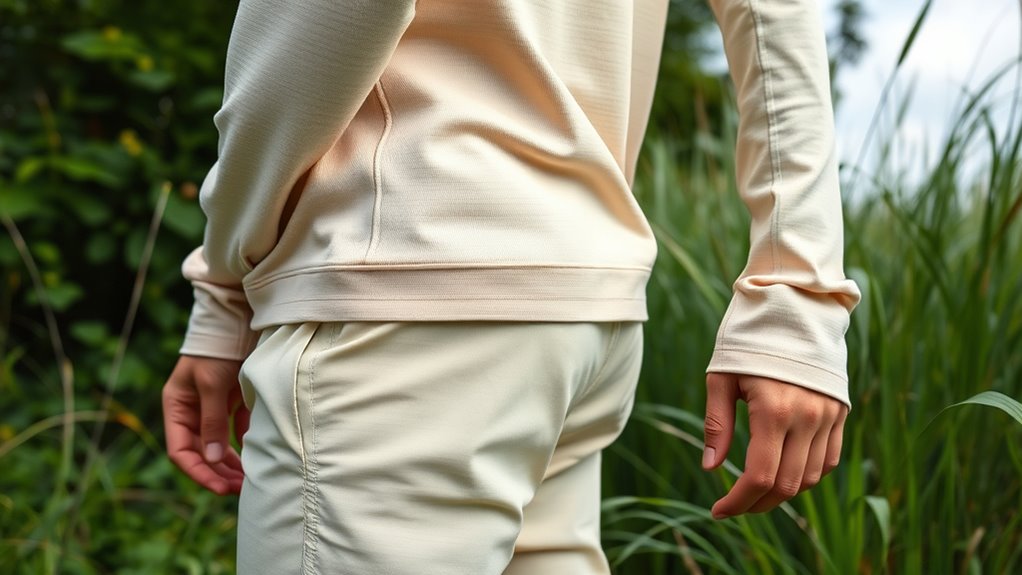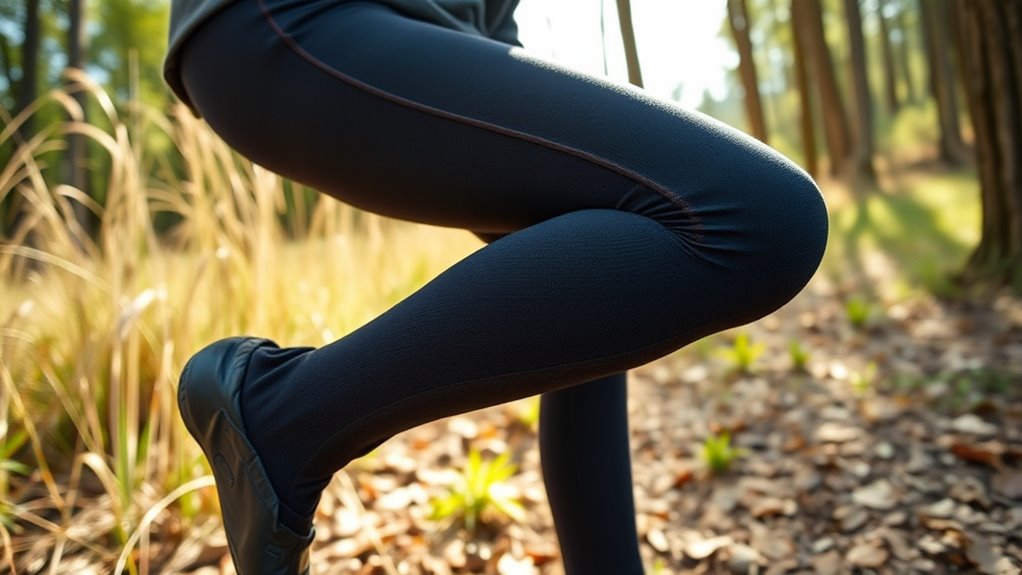When choosing clothing for tick-prone areas, opt for long-sleeved shirts and pants made of tightly woven, lightweight fabrics in light colors to spot ticks easily. Guarantee the fit is snug but comfortable, and wear protective accessories like hats and gaiters to cover exposed skin. Adding insect-repellent treatments can boost your protection. Staying flexible and comfortable helps you stay alert and mobile—if you want to learn more, there’s plenty of helpful advice ahead.
Key Takeaways
- Wear long-sleeved shirts and pants made of tightly woven, high thread count fabrics for effective tick prevention.
- Choose light-colored clothing to easily spot ticks and debris during routine checks.
- Ensure clothing fits well and allows flexibility for comfortable movement and quick reactions.
- Opt for lightweight, breathable materials in warmer months and add insulation in cooler seasons for year-round protection.
- Use protective accessories like hats and gaiters, made of breathable fabrics, to cover exposed areas and reduce tick access.
Selecting Long-Sleeved Shirts and Pants

Wearing long-sleeved shirts and pants is one of the most effective ways to protect yourself from ticks when spending time in tick-prone areas. Layering techniques help create a barrier, especially when combined with tightly woven fabrics. During peak tick seasons, typically spring and summer, opt for lightweight, breathable materials to stay comfortable while maintaining protection. In cooler months, add thermal or insulated layers underneath, ensuring your outer clothing remains long-sleeved and full-length. Pay attention to seasonal considerations: ticks are most active when temperatures are moderate, so adjust your clothing accordingly. Proper layering not only shields your skin but also makes it easier to remove or add clothing as needed, helping you stay safe without sacrificing comfort. Additionally, choosing clothing with high thread counts can further reduce the chances of tick bites penetrating your clothing.
Opting for Light-Colored Fabrics

Choosing light-colored fabrics can markedly improve your chances of spotting ticks before they reach your skin. Light colors create a strong color contrast against the dark or reddish-brown ticks, making them easier to see on your clothing. This quick visual check allows you to remove ticks promptly, reducing the risk of bites. Additionally, light fabrics help with stain concealment, so if you do get a tick or other debris, it’s less noticeable and easier to spot during routine inspections. Dark clothing might hide ticks or stains, increasing your chances of missing a potential hazard. Opting for light-colored clothing is a simple yet effective way to stay vigilant and protect yourself from tick bites while enjoying outdoor activities. Incorporating visualization techniques to imagine a safe and tick-free environment can also enhance your awareness and readiness.
Choosing Tight-Weave Materials

Opting for clothing made from tight-weave fabrics adds an extra layer of protection by making it harder for ticks to penetrate your clothing and reach your skin. Tight-weave materials are known for their fabric durability, so they withstand outdoor wear and tear better than looser weaves. This durability ensures your clothing remains effective over time, maintaining a barrier against ticks. Additionally, choosing fabrics in colors that contrast with the environment helps you spot ticks more easily before they latch on. Avoid lightweight or loosely woven textiles, as they offer less protection. Investing in tight-weave clothing combines strength and functionality, creating a reliable shield. By selecting durable, tightly woven fabrics in contrasting colors, you enhance your defense against ticks and reduce the risk of bites. Regular checks on your clothing for ticks can further improve your protection, especially if you choose the right fabrics.
Wearing Tightly Fitted Clothing

Tightly fitted clothing acts as a crucial barrier by reducing the amount of exposed skin where ticks can latch on. When you choose clothing that fits snugly, it’s less likely for ticks to crawl underneath or cling to loose fabric. Opt for durable fabrics that can withstand outdoor conditions and resist tears, ensuring your clothing maintains its tight fit over time. While fashion considerations are important, prioritize practicality—select clothing that is both functional and comfortable. Tight-fitting garments, such as long-sleeve shirts and pants, help prevent ticks from reaching your skin. Remember, the goal is to create a physical barrier that minimizes exposure, so choose well-fitted, durable clothing that stays secure during your outdoor adventures. Additionally, selecting clothing made from tick-resistant fabrics can further enhance protection by reducing the likelihood of tick attachment.
Utilizing Insect-Repellent Clothing and Treatments

Using insect-repellent clothing and treatments can considerably reduce your risk of tick bites during outdoor activities. You can wear clothing pre-treated with permethrin or apply insect repellent sprays directly to your gear. These methods create a barrier that deters ticks from attaching. To maximize effectiveness, consider:
Insect-repellent clothing and treatments significantly lower your risk of tick bites outdoors.
- Wearing long-sleeved shirts and pants treated with permethrin
- Applying insect repellent sprays containing DEET or Picaridin on exposed skin
- Choosing clothing with tight weaves to prevent tick access
- Re-treating clothing with permethrin after multiple washes
- Covering ankles and wrists with treated gaiters or leggings
- Incorporating protective clothing styles like crochet or fabric decorating markers to customize your gear for better coverage
Utilizing these insect-repellent clothing options and treatments markedly enhances your protection, making outdoor adventures safer in tick-prone areas.
Incorporating Protective Accessories Like Hats and Gaiters

Adding protective accessories like hats and gaiters can substantially reduce your risk of tick bites by covering areas that are often exposed. Wide-brim hats not only shield your face and neck but also provide UV protection, helping prevent sun damage. Gaiters cover your ankles and lower legs, creating a barrier against ticks climbing onto your skin. When choosing these accessories, consider both function and fashion; modern designs now blend protection with style, so you don’t have to sacrifice appearance for safety. Opt for lightweight, breathable fabrics that wick moisture and keep you comfortable during outdoor activities. Incorporating these accessories into your clothing routine enhances your defense against ticks while maintaining a practical, fashionable look. This simple step can make a significant difference in tick prevention in tick-prone environments.
Maintaining Comfort and Mobility While Staying Protected

To stay comfortable and mobile in tick-prone areas, choose breathable fabrics that keep you cool and dry. Make sure your clothing fits well and offers enough flexibility so you can move freely without sacrificing protection. Finding the right balance helps you enjoy outdoor activities without feeling restricted. Additionally, practicing creative problem-solving can help you identify innovative ways to incorporate protective clothing options that suit your needs.
Breathable Fabric Choices
Choosing breathable fabrics is essential for staying comfortable and mobile while protecting yourself in tick-prone areas. Opt for materials that wick moisture away from your skin, keeping you dry and reducing the risk of irritation. Look for UV resistant fabrics that shield you from harmful rays without trapping heat. These fabrics help regulate your body temperature during outdoor activities. For added protection, consider the presence of mold indicators in your clothing, which can signal the need for cleaning or replacement to prevent skin irritation.
Proper Fit and Flexibility
Ensuring your clothing fits properly and offers enough flexibility is crucial for maintaining both comfort and mobility in tick-prone areas. Well-fitting layered clothing allows you to move freely without restricting your movements, which is essential when hiking or working outdoors. Choose moisture-wicking fabrics that keep sweat away from your skin, preventing discomfort and reducing the temptation to adjust or remove layers. Flexibility is key; your clothing should stretch and bend with your body, especially at joints, so you stay agile and protected. Avoid tight, restrictive garments that limit movement or cause chafing. Proper fit and flexibility ensure you remain comfortable during extended outdoor activities, making it easier to stay vigilant for ticks while enjoying your time in nature. Incorporating comfortable and flexible clothing made from appropriate materials can significantly enhance your outdoor experience and safety.
Frequently Asked Questions
How Often Should I Wash Treated Insect-Repellent Clothing?
You should wash treated insect-repellent clothing after every few wears, especially if you’ve been in tick-prone areas. Frequent washing helps maintain the effectiveness of the treatment, but it can also impact clothing durability over time. To balance this, follow the care instructions carefully. Typically, washing every 3-5 wears preserves both the insect-repellent properties and the clothing’s durability, ensuring you stay protected without damaging your gear.
Can Wearing Multiple Layers Increase Fire Risk or Discomfort?
Wearing multiple layers can boost your layering comfort, but it may also increase fire risks if you’re near open flames or heat sources. To stay safe, prioritize fire safety considerations by choosing flame-resistant fabrics and avoiding loose, flammable clothing. While layering keeps you warm and protected from ticks, always be mindful of your environment and remove extra layers when around potential fire hazards to prevent accidents.
Are There Specific Brands Known for Effective Tick-Proof Clothing?
You ask about brands known for effective tick-proof clothing. While some brands have a strong reputation for quality, it’s essential to consider material durability and how well they prevent ticks from reaching your skin. Look for brands that use tightly woven fabrics or treated materials, and read reviews to ensure their clothing lives up to the reputation. Staying informed helps you choose the best protection against ticks in your outdoor adventures.
How Do I Prevent Clothing From Chafing During Long Hikes?
Think of your clothing as a trusted shield on your journey. To prevent chafing during long hikes, you need a fabric that breathes like a gentle breeze, keeping your skin cool and dry. Prioritize seam comfort, avoiding rough stitches that can cause friction. Opt for well-fitting, moisture-wicking layers, and consider seamless or flat-seam designs. This way, your gear moves with you, ensuring a smooth, comfortable trek through the wild.
Is UV Protection Affected by Wearing Long-Sleeved Clothing?
Wearing long-sleeved clothing can still offer UV protection, but its effectiveness depends on fabric thickness and material. Thicker fabrics tend to block more UV rays, keeping your skin safer during sun exposure. Look for clothing labeled with UPF ratings for ideal protection. Keep in mind, natural fabrics like cotton may offer less UV defense than specialized synthetic fabrics designed for sun protection. Always choose wisely for maximum coverage and safety.
Conclusion
Think of choosing the right clothing as building a fortress against ticks. Just like a sturdy wall keeps out invaders, your long sleeves, light fabrics, and protective gear create a barrier that keeps ticks at bay. I once hiked through a tick-prone area in lightweight, tightly woven clothing, and not a single bug bothered me. When you prioritize protection, you’re not just dressing up — you’re arming yourself with an invisible shield that keeps you safe and comfortable.










